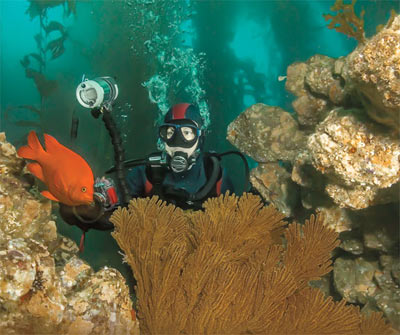At the present time an extraordinary process is happening which will forever alter the marine landscape of California’s waters. In response to a legislative mandate, a team of scientists and Department of Fish and Game managers are selecting and mapping out a series of Marine Protected Areas (“MPA”) with a goal of ensuring the preservation of our marine heritage. The driving process is a Bill known as the Marine Life Protection Act (“MLPA”) that became effective January 1, 2000. The MLPA requires that a significant portion of coastal and offshore island habitat be set aside and protected for future generations.
Square in the path of this controversial process lies Catalina Island. It has over 54 miles of coastline and a permanent protection for 42,000 acres (86 percent) of its land under the stewardship of the Catalina Conservancy. Located only 20 miles from the coast and within a day’s reach of almost 15 million people, Catalina offers the opportunity for incredible recreation pursuits. Sadly, its marine environment has a good chance of being destroyed as we “love it to death.” In my 35-year diving career I have been a personal witness to the continued decline and serial depletion of its underwater riches.
We now have the opportunity to preserve a significant portion of what remains and restore it to the grandeur that has drawn millions to its waters. The Initial Draft Concept for MPA’s on Catalina contemplates setting aside 20 percent of the coastal habitats into no-take marine reserves and given total protection. The MLPA planning team has done a magnificent job in identifying the critical island habitats that will serve as reservoirs for marine plants and animals. It is the other 80 percent that are of concern at this time. Under the MLPA, a significant part of the remaining area must be designated for varying degrees of protection. Herein lies our opportunity to create a lasting legacy to our children, and their children.
Several groups have asked the MLPA planning team to designate the remaining 80 percent as a State Marine Park. This designation would reserve the use of the island solely for recreational pursuits. Fishing, diving, kayaking, boating and the full range of water-oriented activities would remain unaffected. Only commercial, extractive uses would be curtailed. I strongly support this concept and ask that you do as well.
Seldom in our lifetimes do we have the opportunity to make a real difference in the quality of life we will enjoy for ourselves and leave to our families. We have one here. It is within our grasp to create the largest marine park in California history and preserve and protect some of the earth’s most beautiful underwater forests and landscapes. California has some of the best examples of terrestrial parks in the world. Yosemite, Sequoia and Redwood National Park come to mind. We have no parallel for the marine world. I believe it is time to create one.
Virtually all of Catalina’s land is already a de facto park. The concept is not complete, for the environments of the land and sea are not separate and the mean high tide line does not define Catalina, its waters do. Catalina island and the sea. They are welded at the hip and an inseparable pair. From its mountain peaks to the last frond in the kelp forest, this is one ecosystem and deserves and demands to be treated as such. The waters surrounding Catalina deserve the same level of protection that its land already enjoys. The economics are also in our favor. By every study reported, the value to local and state business of a dollar spent on recreational pursuits dwarfs the impact of those same dollars spent on commercial goods. Stripped to the bare bones of the filthy lucre, recreational spending is far better for the state than extractive sales. Conservation even pays for itself in the long run. Enhancing the marine environment will bring thousands more divers to Catalina to enjoy one of the world’s best diving areas.
Divers have a unique perspective on the marine environment. We see a part of it that even the most ancient of mariners could only imagine. We are the ambassadors for the ocean. If divers do not educate themselves to the issues surrounding management of California’s marine resources, then a significant portion of the environment will be misunderstood and under-represented.
Our proposal has significant opposition. It is new, it is large, it is controversial, but it is the right thing to do. Our detractors are consumed with greed and fear and offer little in return to the people. We offer hope. Hope for a child bubbling with laughter and joy as they catch their first fish. Wonder fills the eyes of divers when they glide through a cathedral of light as they swim through the kelp forests. We offer a retreat for those who wish to escape the crushing blanket of humanity of the Southern California metropolitan area. We offer hope in a hearts of a loving couple who walk unspoiled beaches and dream of that shining place across the sea known as Avalon.
For information on the proposal to create the Catalina State Marine Park and for information on the MLPA process and how to contact the Department of Fish and Game, see www.kelpforestcoalition.org or the DFG website at www.dfg.ca.gov/mrd/mlpa/index.html. I urge you to educate yourselves on the issues and become involved in the process. Opportunities such as we have now may not recur in our lifetimes. We may not be able to save the whole world, but each of us can save a small piece.










